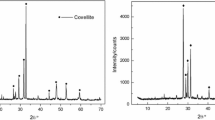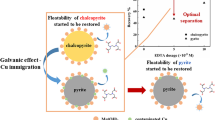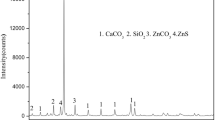Abstract
In the present work, a biosurfactant-producing and sulfur-oxidizing mixotrophic bacterium (identified as Citrobacter sp.) was studied as flotation reagents to substitute for several hazardous chemical reagents to establish a cleaner and greener mineral processing. The mixotrophic bacterium Citrobacter sp. was adapted with galena (PbS) concentrate or sphalerite (ZnS) concentrate or silica (SiO2) mineral to modify the hydrophobicity of mineral surfaces as described by contact angle measurements, scanning electron microscopy equipped with energy-dispersive X-ray spectroscopy (SEM–EDS), and Fourier transform infrared (FTIR) spectroscopy. Furthermore, the bacterium application as potential flotation reagents in the bioflotation of complex Pb–Zn ore in a 2.5-l laboratory-scale Denver flotation cell showed that the mixotrophic bacterium could function as flotation bioreagents by producing metabolites apart from its bacterial cells. The bacterial action as flotation bioreagents included collector, frother, and depressant due to its capability in producing biosurfactants and oxidizing sulfur with a moderate capacity in oxidizing iron. Its function yielded the high flotation recovery of lead (Pb: ~ 90%) and zinc (Zn: ~ 80%) and higher Pb and Zn grade in concentrate with respect to pH, conditioning time, and bacterial cell concentration. From an industrial viewpoint, the findings of this study might be very prospective for the improvement of more cost-effective and eco-friendly flotation reagents.
Graphical Abstract








Similar content being viewed by others
References
Govender Y, Gericke M (2011) Extracellular polymeric substances (EPS) from bioleaching systems and its application in bioflotation. Miner Eng 24:1122–1127. https://doi.org/10.1016/j.mineng.2011.02.016
Han G, Wen S, Wang H, Feng Q (2019) Effect of starch on surface properties of pyrite and chalcopyrite and its response to flotation separation at low alkalinity. Miner Eng 143:106015. https://doi.org/10.1016/j.mineng.2019.106015
Khoso SA, Hu Y, Lyu F et al (2019) Selective separation of chalcopyrite from pyrite with a novel non-hazardous biodegradable depressant. J Clean Prod 232:888–897. https://doi.org/10.1016/j.jclepro.2019.06.008
Merma AG, Torem ML, Morán JJV, Monte MBM (2013) On the fundamental aspects of apatite and quartz flotation using a Gram positive strain as a bioreagent. Miner Eng 48:61–67. https://doi.org/10.1016/j.mineng.2012.10.018
Sarvamangala H, Natarajan KA, Girisha ST (2013) Microbially-induced pyrite removal from galena using Bacillus subtilis. Int J Miner Process 120:15–21. https://doi.org/10.1016/j.minpro.2013.02.005
Dıáz-López CV, Pecina-Trevinõ ET, Orrantia-Borunda E (2012) A study of bioflotation of chalcopyrite and pyrrhotite mixtures in presence of L. ferrooxidans. Can Metall Q 51:118–125. https://doi.org/10.1179/0008443312Z.00000000025
Pecina-Treviño ET, Ramos-Escobedo GT, Gallegos-Acevedo PM et al (2012) Bioflotation of sulfide minerals with Acidithiobacillus ferrooxidans in relation to copper activation and surface oxidation. Can J Microbiol 58:1073–1083. https://doi.org/10.1139/w2012-072
Didyk AM, Sadowski Z (2012) Flotation of serpentinite and quartz using biosurfactants. Physicochem Probl Miner Process 48:607–618. https://doi.org/10.5277/ppmp120224
Chandraprabha MN, Natarajan KA (2006) Surface chemical and flotation behaviour of chalcopyrite and pyrite in the presence of Acidithiobacillus thiooxidans. Hydrometallurgy 83:146–152. https://doi.org/10.1016/j.hydromet.2006.03.021
Chandraprabha MN, Natarajan KA, Somasundaran P (2005) Selective separation of pyrite from chalcopyrite and arsenopyrite by biomodulation using Acidithiobacillus ferrooxidans. Int J Miner Process 75:113–122. https://doi.org/10.1016/j.minpro.2004.08.014
Chandraprabha MN, Natarajan KA, Modak JM (2004) Selective separation of pyrite and chalcopyrite by biomodulation. Colloids Surf B Biointerfaces 37:93–100. https://doi.org/10.1016/j.colsurfb.2004.06.011
Subramanian S, Santhiya D, Natarajan KA (2003) Surface modification studies on sulphide minerals using bioreagents. Int J Miner Process 72:175–188. https://doi.org/10.1016/S0301-7516(03)00097-8
Silva AC, Valentim D, Cara C et al (2018) Apatite bioflotation using spent yeast (Saccharomyces cerevisiae) cells as collector. Tecnol em Met Mater Miner 15:475–480
Luque Consuegra G, Kutschke S, Rudolph M, Pollmann K (2020) Halophilic bacteria as potential pyrite bio-depressants in Cu–Mo bioflotation. Miner Eng 145:106062. https://doi.org/10.1016/j.mineng.2019.106062
Hacha RR, Leonardotorem M, Merma AG, Figueiredo V (2018) Electro flotation of fine hematite particles with Rhodococcus opacus as a biocollector in a modified Partridge–Smith cell. Miner Eng 126:105–115. https://doi.org/10.1016/j.mineng.2018.06.025
Merma AG, Oliv CAC, Torem ML, Santos BF (2018) Comparison study of hematite bioflotation by R. erythropolis and its biosurfactant: experiments and neural network modeling. Chem Eng Trans 65:439–444. https://doi.org/10.3303/CET1865074
San Martín F, Kracht W, Vargas T (2018) Biodepression of pyrite using Acidithiobacillus ferrooxidans in seawater. Miner Eng 117:127–131. https://doi.org/10.1016/j.mineng.2017.11.005
San Martín F, Kracht W, Vargas T, Rudolph M (2020) Mechanisms of pyrite biodepression with Acidithiobacillus ferrooxidans in seawater flotation. Miner Eng 145:106067. https://doi.org/10.1016/j.mineng.2019.106067
Merma AG, Olivera CAC, Hacha RR et al (2019) Optimization of hematite and quartz bioflotation by AN artificial neural network (ANN). J Mater Res Technol 8:3076–3087. https://doi.org/10.1016/j.jmrt.2019.02.022
Bleeze B, Zhao J, Harmer SL (2018) Selective attachment of Leptospirillum ferrooxidans for separation of chalcopyrite and pyrite through bio-flotation. Minerals 8:7–14. https://doi.org/10.3390/min8030086
Kim G, Choi J, Silva RA et al (2017) Feasibility of bench-scale selective bioflotation of copper oxide minerals using Rhodococcus opacus. Hydrometallurgy 168:94–102. https://doi.org/10.1016/j.hydromet.2016.06.029
Kim G, Park K, Choi J et al (2015) Bioflotation of malachite using different growth phases of Rhodococcus opacus: effect of bacterial shape on detachment by shear flow. Int J Miner Process 143:98–104. https://doi.org/10.1016/j.minpro.2015.09.012
Sanwani E, Mirahati RZ, Chaerun SK (2017) Recovery of copper from pyritic copper ores using a biosurfactant-producing mixotrophic bacterium as bioflotation reagent. Solid State Phenom 262:181–184. https://doi.org/10.4028/www.scientific.net/SSP.262.181
Sanwani E, Hidayati D, Khodijah Chaerun S (2016) Utilization of the bacteria Bacillus pumilus and Citrobacter youngae as flotation bioreagents in the microflotation of chalcopyrite, pyrite, and silica. Microbiol Indones 10:15–22. https://doi.org/10.5454/mi.10.1.3
Sanwani E, Chaerun S, Mirahati RZ, Wahyuningsih T (2016) Bioflotation: bacteria-mineral interaction for eco-friendly and sustainable mineral processing. Procedia Chem 19:666–672. https://doi.org/10.1016/j.proche.2016.03.068
Sanwani E, Mirahati RZ, Chaerun SK (2015) Possible role of the biosurfactant-producing and Fe–S-oxidizing bacterium in silicate and sulfide bioflotation processes. Adv Mater Res 1130:493–498. https://doi.org/10.4028/www.scientific.net/amr.1130.493
Sanwani E, Wahyuningsih T, Chaerun SK (2015) Assessment of surface properties of silica-bacterial cell complex: a potential application for silicate bioflotation processes. Adv Mater Res 1130:515–518. https://doi.org/10.4028/www.scientific.net/amr.1130.515
Mubarok MZ, Winarko R, Chaerun SK et al (2017) Improving gold recovery from refractory gold ores through biooxidation using iron-sulfur-oxidizing/sulfur-oxidizing mixotrophic bacteria. Hydrometallurgy 168:69–75. https://doi.org/10.1016/j.hydromet.2016.10.018
Chaerun SK, Putri EA, Mubarok MZ (2020) Bioleaching of Indonesian galena concentrate with an iron- and sulfur-oxidizing mixotrophic bacterium at room temperature. Front Microbiol 11:1–14. https://doi.org/10.3389/fmicb.2020.557548
Sharma PK (2001) Surface studies relevant to microbial adhesion and bioflotation of sulphide minerals. Luleå University of Technology, Luleå
Sharma PK, Rao KH, Forssberg KSE, Natarajan KA (2001) Surface chemical characterisation of Paenibacillus polymyxa before and after adaptation to sulfide minerals. Int J Miner Process 62:3–25. https://doi.org/10.1016/S0301-7516(00)00043-0
Williams DL, Kuhn AT, Amann MA et al (2010) Computerised measurement of contact angles. Galvanotechnik 101:2502–2512
Chaerun SK, Tazaki K, Okuno M (2013) Montmorillonite mitigates the toxic effect of heavy oil on hydrocarbon-degrading bacterial growth: implications for marine oil spill bioremediation. Clay Miner 48:639–654. https://doi.org/10.1180/claymin.2013.048.4.17
Chaerun SK, Syarif R, Wattimena RK (2020) Bacteria incorporated with calcium lactate pentahydrate to improve the mortar properties and self-healing occurrence. Sci Rep 10:1–9. https://doi.org/10.1038/s41598-020-74127-4
Ellerbrock RH, Kaiser M (2005) Stability and composition of different soluble soil organic matter fractions—evidence from δ13C and FTIR signatures. Geoderma 128:28–37
Das P, Mukherjee S, Sen R (2008) Antimicrobial potential of a lipopeptide biosurfactant derived from a marine Bacillus circulans. J Appl Microbiol 104:1675–1684. https://doi.org/10.1111/j.1365-2672.2007.03701.x
Farahat M, Hirajima T, Sasaki K (2010) Adhesion of Ferroplasma acidiphilum onto pyrite calculated from the extended DLVO theory using the van Oss–Good–Chaudhury approach. J Colloid Interface Sci 349:594–601. https://doi.org/10.1016/j.jcis.2010.05.091
Macaskie LE, Bonthrone KM, Yong P, Goddard DT (2000) Enzymically mediated bioprecipitation of uranium by a Citrobacter sp.: a concerted role for exocellular lipopolysaccharide and associated phosphatase in biomineral formation. Microbiology 146:1855–1867. https://doi.org/10.1099/00221287-146-8-1855
Mandal SM, Sharma S, Pinnaka AK et al (2013) Isolation and characterization of diverse antimicrobial lipopeptides produced by Citrobacter and Enterobacter. BMC Microbiol. https://doi.org/10.1186/1471-2180-13-152
Werkman CH, Gillen GF (1932) Bacteria producing trimethylene glycol 1. J Bacteriol 23:167–182. https://doi.org/10.1128/jb.23.2.167-182.1932
Luo X, Feng B, Wong C et al (2016) The critical importance of pulp concentration on the flotation of galena from a low grade lead-zinc ore. J Mater Res Technol 5:131–135. https://doi.org/10.1016/j.jmrt.2015.10.002
Suyantara GPW, Hirajima T, Miki H et al (2020) Effect of H2O2 and potassium amyl xanthate on separation of enargite and tennantite from chalcopyrite and bornite using flotation. Miner Eng 152:106371. https://doi.org/10.1016/j.mineng.2020.106371
Ohmura N, Kitamura K, Saiki H (1993) Mechanism of microbial flotation using Thiobacillus ferrooxidans for pyrite suppression. Biotechnol Bioeng 41:671–676. https://doi.org/10.1002/bit.260410611
Rohwerder T, Sand W (2007) Mechanisms and biochemical fundamentals of bacterial metal sulfide oxidation. In: Microbial processing of metal sulfides. Springer, Dordrecht, pp 35–58. https://doi.org/10.1007/1-4020-5589-7_2
Mehrabani JV, Mousavi SM, Noaparast M (2011) Evaluation of the replacement of NaCN with Acidithiobacillus ferrooxidans in the flotation of high-pyrite, low-grade lead-zinc ore. Sep Purif Technol 80:202–208. https://doi.org/10.1016/j.seppur.2011.04.006
Vasanthakumar B, Ravishankar H, Subramanian S (2012) A novel property of DNA—as a bioflotation reagent in mineral processing. PLoS ONE 7:1–7. https://doi.org/10.1371/journal.pone.0039316
Acknowledgements
We acknowledge all the members of Geomicrobiology-Biomining & Biocorrosion Laboratory and Microbial Culture Collection Laboratory, Biosciences and Biotechnology Research Center (BBRC), Institut Teknologi Bandung for their cooperation and assistance. This research was financially supported by a grant from the 2019 Research Program (P3MI), Institute for Research and Community Services, Institut Teknologi Bandung, Indonesia. We also thank the editor and three anonymous reviewers for their constructive comments.
Author information
Authors and Affiliations
Contributions
HH conducted the experiments under the supervision of ES and SKC. MAR made figures and tables. SKC and ES wrote and revised the manuscript. All authors reviewed the manuscript before submission.
Corresponding authors
Ethics declarations
Conflict interest
All authors (ES, SKC, HH, and MAR) declare that they have no competing interests.
Additional information
The contributing editor for this article was Grace Ofori-Sarpong.
Publisher's Note
Springer Nature remains neutral with regard to jurisdictional claims in published maps and institutional affiliations.
Rights and permissions
About this article
Cite this article
Sanwani, E., Chaerun, S.K., Husni, H. et al. Surface Modification of Galena Concentrate, Sphalerite Concentrate, and Silica by the Bacterium Citrobacter sp. and Its Application to Green Flotation of Complex Pb–Zn Ores. J. Sustain. Metall. 7, 1265–1279 (2021). https://doi.org/10.1007/s40831-021-00399-3
Received:
Accepted:
Published:
Issue Date:
DOI: https://doi.org/10.1007/s40831-021-00399-3




